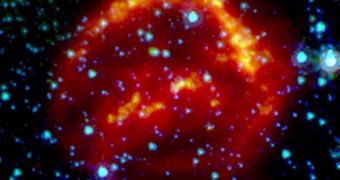A team of scientists managed to identify shards and traces of a massive stellar explosion inside a small piece of space rock, that fell to the Earth more than one and a half centuries ago.
According to the earliest investigations, it would appear that the star which left behind the markings blew up around the same time our solar system developed, or 4.5 billion years ago.
The Sun is a bit older than that, but it was only after a few tens of millions of years that planets began to coalesce and then harden around it.
By analyzing the Orgueil meteorite, which landed in 1864 in France, experts were able to determine that the rock has such peculiar levels of the metallic element chromium.
Concentrations of the stuff were in previous investigations found to vary widely from planet to planet, and from one meteorite or asteroid to the other. Explaining why has always been a challenge.
In the new work, it was determined that the star which blew up was located very close by. With the aid of modern technology, experts were able to discover what kind of celestial body it was.
Researcher Nicolas Dauphas, who is based at the University of Chicago, was the leader of the new work, details of which appear in the September 10 issue of the esteemed Astrophysical Journal.
Studies of how the dust and gas that formed our solar systems must have looked like before collapsing showed that the isotope called chromium 54 should have been evenly dispersed throughout.
But, if that were indeed the case, then the chemical should be found in relatively equal concentrations in all bodies that make up the Sun's neighborhood, which is not the case.
“It was a very well-mixed soup. But it looks like some of the ingredients got in there and didn't get completely homogenized, and that's a pretty interesting result,” explains scientist Bradley Meyer.
The expert holds an appointment as a professor of astronomy and astrophysics at the Clemson University, but he was not involved in this study, Space reports.
Among astronomers, there are groups that suggest the supernova explosion which occurred 4.5 billion years ago is what caused the Sun to form.
“It seems likely that at least one massive star contributed material to the solar system – or what was going to become the solar system – shortly before its birth,” Meyer adds.
“It's remarkable that you can look at an isotope like chromium 54 and potentially find out a whole lot about what happened in the very first period of the solar system's formation,” the expert concludes.

 14 DAY TRIAL //
14 DAY TRIAL //